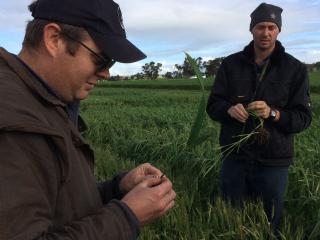Take home findings from frost research trials spanning six seasons will be delivered at the Western Australian grain industry’s key research event.
Department of Primary Industries and Regional Development research scientist Ben Biddulph said cereal trials in frost-prone areas confirmed crop species and sowing date were the greatest drivers of yield.
Detailed findings of the research, supported by the Grains Research and Development Corporation (GRDC), will be presented at the 2020 GRDC Grains Research Updates, Perth.
“We’ve re-evaluated what are the biggest tools in the toolbox when it comes to frost management in cereals, and how to get the most out of these,” Dr Biddulph said.
“Agronomic options for managing frost risk include zoning frost-prone areas and managing them by sowing the appropriate crop types and maturity types, along with stubble and canopy management.
“The interaction of crop species with sowing date is still the greatest driver of yield in both frost prone and non-frost-prone environments.”
Results from frosted trials have showed that delaying head emergence or flowering through maturity and sowing time had the biggest impact on yield and quality, rather than genetic yield potential.
“With April sowing in both frost-prone and non-frost-prone areas, sowing longer season maturity types is a stronger driver of yield and quality,” Dr Biddulph said.
“There is no practical way to ‘beat the frost’ in frost-prone areas by sowing mid-season maturity types of wheat, barley or oats in April. There is a real risk that grain yield and quality will be compromised.”
Dr Biddulph will also deliver new results on trials evaluating the role of canopy management in frost-prone landscapes across the central and southern Wheatbelt.
“We compared nitrogen application and seeding rates with the impact of frost severity and duration, and damage from subsequent frost events, in small plot and farmer scale trials,” Dr Biddulph said.
“Reducing nitrogen and seeding rates to half of usual farmer practice can reduce the severity and duration of a frost event. However, frost damage is not consistently reduced to justify this management strategy as an economic option.
“Reducing nitrogen and seeding rates can cause the canopy to flower several days later and over a wider window, but the crop is not able to consistently avoid frost damage, because a shift in the flowering window of about two weeks is required.
“Variety choice, based on maturity, is a more reliable tool for growers to use to delay flowering and avoid high frost risk periods.
“Growers should continue to sow longer maturity varieties of all crop types and maintain high seeding rates and standard nitrogen inputs to optimise yield potential and profitability in frost-prone landscapes.
“In-season nitrogen applications may be managed according to the likelihood of frost events to minimise financial risk, but growers need to carefully consider the opportunity costs in nitrogen-responsive conditions if there is no frost.”
The 2020 GRDC Grains Research Update will be held in Perth on Monday 24 and Tuesday 25 February, while Regional Updates are scheduled in the weeks following. For details visit the GRDC Updates and events page.

Media contacts:
Jodie Thomson/Katrina Bowers, media liaison +61 (0) 8 9368 3937
